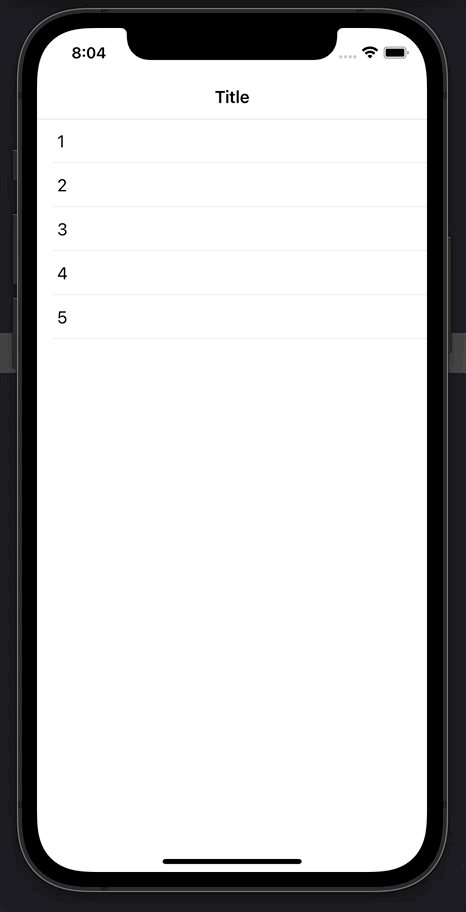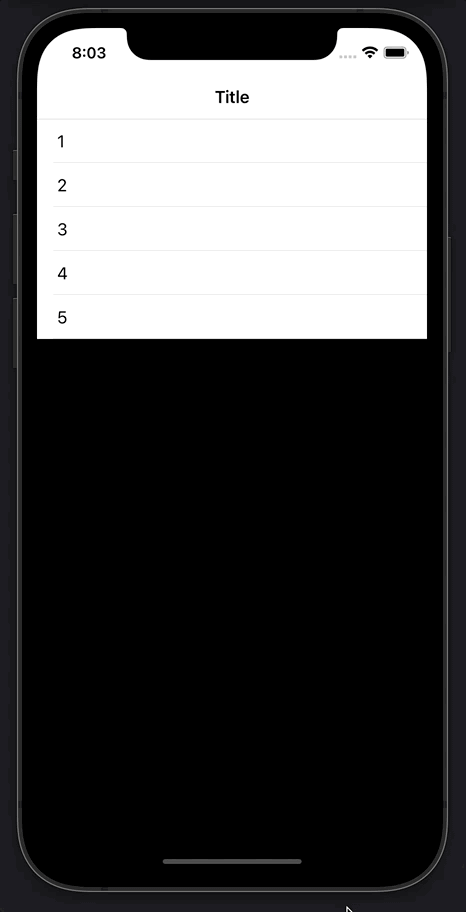UITableView顶部和底部的不同背景颜色
如果您在iPhone OS 3.0的邮件应用程序中查看收件箱,您会看到向下滑动在UISearchBar上方显示浅灰色背景颜色。
现在,如果向下滚动到表格底部,您会看到该端的背景颜色为白色。
我可以想到几种解决这个问题的方法,但它们非常黑客:
- 通过覆盖-scrollViewDidScroll,根据当前的scrollOffset更改表格视图的背景颜色:
- 为UITableView提供清晰的背景颜色,然后将其superview的backgroundColor设置为渐变图案图像。
有谁知道这个问题的“最佳实践”解决方案是什么?感谢。
13 个答案:
答案 0 :(得分:33)
Light gray background in “bounce area”...
有很好的答案我发现这个代码(略微修改)很有用:
CGRect frame = self.tableView.bounds;
frame.origin.y = -frame.size.height;
UIView* grayView = [[UIView alloc] initWithFrame:frame];
grayView.backgroundColor = [UIColor grayColor];
[self.tableView addSubview:grayView];
[grayView release];
夫特:
var frame = self.tableView.bounds
frame.origin.y = -frame.size.height
let grayView = UIView(frame: frame)
grayView.backgroundColor = .gray
self.tableView.addSubview(grayView)
答案 1 :(得分:13)
解决此问题的最简单,最轻量级的方法是:
- 将表格视图的背景颜色设置为您想要的任何颜色 - 在您的情况下为白色。
- 将搜索栏视图放在容器视图中。将表视图的标题视图设置为此容器视图(而不是搜索栏视图本身,这可能是您之前所做的)。
- 在该容器视图中,添加另一个子视图,其框架等于矩形(0,-480,320,480),并将该子视图的背景颜色设置为您想要的任何颜色 - 在您的情况下,为浅灰色。 / LI>
这应该就是你需要做的一切。我自己做了这个并实现了我想要的外观,与Mail应用程序完全相同。使用scrollViewDidScroll是CPU资源的主要浪费,而子类化UITableView是超级混乱的,IMO。
答案 2 :(得分:12)
将tableFooterView设置为0高度和宽度的视图,该视图超出其边界。一种简单的方法是为其添加一个大的子视图:
self.tableView.tableFooterView = [[[UIView alloc] initWithFrame:CGRectZero] autorelease];
UIView *bigFooterView = [[UIView alloc] initWithFrame:CGRectMake(0, 0, 320, 1000)];
bigFooterView.backgroundColor = [UIColor whiteColor];
bigFooterView.opaque = YES;
[self.tableView.tableFooterView addSubview:bigFooterView];
[bigFooterView release];
相应地调整[UIColor whiteColor]和bigFooterView的宽度(如果你的tableView可以变为水平,你会希望它宽于320)。这种方式在顶部你会看到你的桌面视图背景,无论你设置这个视图的背景是什么。
答案 3 :(得分:8)
由Erica Sadun提供:
- (void) scrollViewDidScroll: (UIScrollView *) sv
{
float percent = sv.contentOffset.y / sv.contentSize.height;
percent = 0.5 + (MAX(MIN(1.0f, percent), 0.0f) / 2.0f);
sv.backgroundColor = [UIColor colorWithRed:percent * 0.20392
green:percent * 0.19607
blue:percent * 0.61176 alpha: 1.0f];
}
然后这是我正在使用的修改版本:
- (void)scrollViewDidScroll:(UIScrollView *)sv
{
UIColor *backgroundColor = nil;
float percent = sv.contentOffset.y / sv.contentSize.height;
percent = 0.5 + (MAX(MIN(1.0f, percent), 0.0f) / 2.0f);
if (0.5f == percent)
{
backgroundColor = RGBCOLOR(233.0f, 235.0f, 237.0f);
}
else
{
CGFloat r = 233.0f * (1.0f - percent) + 255.0f * percent;
CGFloat g = 235.0f * (1.0f - percent) + 255.0f * percent;
CGFloat b = 237.0f * (1.0f - percent) + 255.0f * percent;
backgroundColor = RGBCOLOR(r,g,b);
}
sv.backgroundColor = backgroundColor;
}
答案 4 :(得分:7)
这是Swift 3版本:
var frame = self.tableView.bounds
frame.origin.y = -frame.size.height
let view = UIView(frame: frame)
view.backgroundColor = .gray
self.tableView.addSubview(view)
答案 5 :(得分:4)
具有扩展功能的Swift 3.0+可重用解决方案:
extension UITableView {
func addTopBounceAreaView(color: UIColor = .white) {
var frame = UIScreen.main.bounds
frame.origin.y = -frame.size.height
let view = UIView(frame: frame)
view.backgroundColor = color
self.addSubview(view)
}
}
用法:tableView.addTopBounceAreaView()
答案 6 :(得分:3)
这可能不是“最佳做法”,但如果您真的想像Apple那样做,那么就会有一个名为UITableView的私有tableHeaderBackgroundColor属性。浅灰色为#e2e7ed。
您可以在-viewDidLoad的{{1}}方法中添加类似内容:
UITableViewController答案 7 :(得分:2)
我使用autolayouts解决了这个问题。该解决方案适用于不同的屏幕尺寸和方向变化。
self.tableView.tableFooterView = UIView();
if let tableFooterView = self.tableView.tableFooterView {
let bigFooterView = UIView();
bigFooterView.backgroundColor = UIColor.white;
bigFooterView.isOpaque = true;
tableFooterView.addSubview(bigFooterView);
bigFooterView.translatesAutoresizingMaskIntoConstraints = false;
tableFooterView.addConstraint(NSLayoutConstraint(item: bigFooterView, attribute: .trailing, relatedBy: .equal, toItem: tableFooterView, attribute: .trailing, multiplier: 1, constant: 0));
tableFooterView.addConstraint(NSLayoutConstraint(item: bigFooterView, attribute: .leading, relatedBy: .equal, toItem: tableFooterView, attribute: .leading, multiplier: 1, constant: 0));
tableFooterView.addConstraint(NSLayoutConstraint(item: bigFooterView, attribute: .top, relatedBy: .equal, toItem: tableFooterView, attribute: .top, multiplier: 1, constant: 0));
tableFooterView.addConstraint(NSLayoutConstraint(item: bigFooterView, attribute: .height, relatedBy: .equal, toItem: nil, attribute: .notAnAttribute, multiplier: 1, constant: 1000));
}
答案 8 :(得分:1)
我已将Light gray background in “bounce area” of a UITableView中的答案扩展到底部。希望这会有所帮助:)
CGRect topFrame = self.tableView.bounds;
topFrame.origin.y = -topFrame.size.height;
UIView* topView = [[UIView alloc] initWithFrame:topFrame];
topView.backgroundColor = [UIColor grayColor]; // change to any color you want
[self.tableView addSubview:topView];
CGRect bottomFrame = self.tableView.bounds;
bottomFrame.origin.y = self.tableView.contentSize.height;
UIView* bottomView = [[UIView alloc] initWithFrame:bottomFrame];
bottomView.backgroundColor = [UIColor grayColor]; // change to any color you want
[self.tableView addSubview:bottomView];
答案 9 :(得分:0)
这是我的解决方案:
let topColor = UIColor.blue
let bottomColor = UIColor.black
self.tableView.backgroundColor = topColor
self.tableView.tableFooterView = UIView(frame: CGRect.zero)
let footerView = UIView(frame: CGRect(x: 0, y: 0, width: view.frame.width, height: 1000))
footerView.backgroundColor = bottomColor
self.tableView.tableFooterView?.addSubview(footerView)
答案 10 :(得分:0)
SwiftUI 解决方案
var body: some View {
NavigationView {
List(data, id: \.self) { data in
Text("\(data)")
}
.onAppear {
let headerView = UIView(frame: CGRect(x: 0, y: -400, width: UIScreen.main.bounds.width, height: 400.0))
headerView.backgroundColor = .lightGray
UITableView.appearance().addSubview(headerView)
}
.navigationBarTitle("Title", displayMode: .inline)
}
}
如果您想在列表下方使用不同的背景颜色,请添加另一个 UIView 以更改背景视图:
let backgroundView = UIView()
backgroundView.backgroundColor = .black
UITableView.appearance().backgroundView = backgroundView
答案 11 :(得分:-1)
您应该考虑使用tableHeaderView的{{1}}和tableFooterView属性。
答案 12 :(得分:-1)
我认为您只想将单元格的BG颜色设置为白色,并将表格的BG颜色设置为另一种(灰色)颜色。我不确定你是否已经成功尝试使用透明细胞。
- 我写了这段代码,但我无法理解我的错误
- 我无法从一个代码实例的列表中删除 None 值,但我可以在另一个实例中。为什么它适用于一个细分市场而不适用于另一个细分市场?
- 是否有可能使 loadstring 不可能等于打印?卢阿
- java中的random.expovariate()
- Appscript 通过会议在 Google 日历中发送电子邮件和创建活动
- 为什么我的 Onclick 箭头功能在 React 中不起作用?
- 在此代码中是否有使用“this”的替代方法?
- 在 SQL Server 和 PostgreSQL 上查询,我如何从第一个表获得第二个表的可视化
- 每千个数字得到
- 更新了城市边界 KML 文件的来源?

